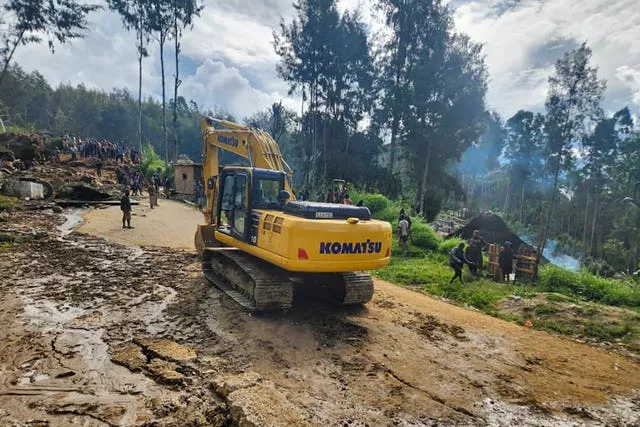Authorities fear a second landslide and a disease outbreak are looming at the scene of Papua New Guinea’s mass-casualty disaster.
Waterways could be at risk of contamination from disaster debris and the rotting corpses of those that remain in the rubble, a United Nations official said on Tuesday.
A mass of boulders, earth and splintered trees devastated Yambali in the South Pacific nation’s remote highlands when a limestone mountainside sheared away on Friday.
Serhan Aktoprak, chief of the International Organisation for Migration’s mission in Papua New Guinea, said the debris blanket has become more unstable due to recent rain and streams trapped between the ground and rubble.
The UN agency has officials at the scene in Enga province, helping shelter 1,600 displaced people.
The agency estimates 670 villagers died, while Papua New Guinea’s government has told the United Nations it thinks more than 2,000 people were buried. Five bodies had been retrieved from the rubble by Monday.
“We are hearing suggestions that another landslide can happen, and maybe 8,000 people need to be evacuated,” Mr Aktoprak told The Associated Press.
“This is a major concern. The movement of the land and the debris are causing a serious risk, and overall, the total number of people that may be affected might be 6,000 or more,” he said. That includes villagers whose source of clean drinking water has been buried and subsistence farmers who lost their vegetable gardens.
“If this debris mass is not stopped, if it continues moving, it can gain speed and further wipe out other communities and villages further down the mountain,” Mr Aktoprak said.
Scenes of villagers digging with their bare hands through muddy debris in search of their relatives’ remains were also concerning.
“My biggest fear at the moment is corpses are decaying… water is flowing, and this is going to pose serious health risks about contagious diseases,” Mr Aktoprak said.
His agency was raising those concerns at Tuesday’s disaster management virtual meeting of national and international responders.
The warning comes as geotechnical experts and heavy earth-moving equipment are expected to reach the site soon.

On Sunday, the Papua New Guinea government officially asked the United Nations for additional help and to co-ordinate contributions from individual nations.
An Australian disaster response team was scheduled to arrive on Tuesday in Papua New Guinea, which is Australia’s nearest neighbour.
It will include a geohazard assessment team and drones to help map the site.
“Their role will be particularly helping perform geotechnical surveillance to establish the level of the landslip, the instability of the land there, obviously doing some work around identifying where bodies are,” Australia’s minister for emergency management Murray Watt told the Australian Broadcasting Corporation.
Australia’s minister for the Pacific, Pat Conroy, said the government would also provide long-term logistical support for clearing debris, recovering bodies, and supporting displaced people.
The government announced an initial aid package of 2.5 million dollars (£1.3 million).
“This is an incredibly inaccessible part of Papua New Guinea, and it’s a really challenging process for everyone involved,” Mr Conroy said.
Earth-moving equipment used by Papua New Guinea’s military was expected to arrive soon after travelling from the city of Lae, 400 kilometres (250 miles) to the east, said Justine McMahon, country director of the humanitarian agency Care International.
The landslide buried the province’s main highway’s 200-metre (650-foot) stretch.
“One of the complicating factors was the destruction of parts of the road plus the instability of the ground, but they have some confidence that they can take in heavy equipment today,” Mr McMahon said on Tuesday.
An excavator donated by a local builder on Sunday became the first piece of heavy earth-moving machinery to help villagers digging with shovels and farming tools to find bodies.
Papua New Guinea is a diverse, developing nation with 800 languages and 10 million people who are mostly subsistence farmers.
Signup bonus from





